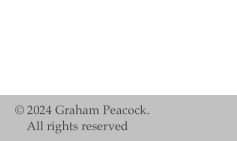|
Color and Dimension
the recent paintings of Graham Peacock
Beyond Formalism by Roger Boulet
The word formalism* in the old Soviet Union was used to deride virtually anything that strayed from the doctrine of soviet realism and could, in fact, be applied to just about any art form whose expression did not meet with official approval. Some of the greatest music of our time, that of Shostakovitch and of Prokofiev, was derided as formalistic when the expression was considered too personal and too idiosyncratic or too involved with the exploration of new musical expressions. Abstract art was equally suspect because it was deemed too self-referential; that is too involved with art itself, rather than with life and the progress of socialism.
It would seem that in our insatiable thirst for the new, we have rushed to adopt a number of marxist principles in a "post-modern" world and we have swallowed an agenda, much of which seems to be unsympathetic to the traditions of freedom of individual expression which our society has always held as being of utmost importance, a tradition which in academic circles is held as a sacred trust. The movement of political correctness and its zeal to prescribe correct ways of thinking is symptomatic of this pernicious intolerance, to the detriment of an informed discourse.
Over the years, I have found that the intolerance of the so-called formalist artists towards artists who sought to return to a kind of art with allegedly non-pictorial content, (emotional, ideological and personal), has been met by an equally strong intolerance held by the more 'content-oriented' artists who feel that any art that is purely self-referential is merely self-indulgent repetition of outdated principles and formulas. And the futile debate continues, totally irrational on both sides. It is the fruitless debate between fundamentalism and established religions.
Graham Peacock's painting would seem to stem from the modernist, so-called "formalist" (i.e. Greenbergian) principles which in Edmonton have continued to dominate the visual art scene for 20 years. I am beginning to believe, however, in the most recent work especially, that Peacock's work has almost made the debate a non-issue in that the painting seems to transgress so many of the principles of 'good taste' dearly held by the "formalists" and is met with studied incomprehension by the others. Because the colour in these works shouts its dissonances and irreverence to old sensibilities, much as Gerhard Richter's new brilliantly coloured abstract paintings have done, the work is usually encountered with a considerable amount of skepticism. The abandonment of the conventional rectangle; the many violations to the integrity of the sacred flat picture plane, the outrageous textures, padding, assemblage creates a late Twentieth century kind of merzbilden, which even Schwitters would find daring.
The question is: where will these works eventually take Peacock? We are either witnessing the last gasp of "formalism" in a blaze of form and colour and texture, or we are attending to the birth of a new kind of painting which will be complete when none of the prescriptions of the past or present are held by the artist but are supplanted by new processes and point to new principles which are beyond current theorizing and have yet to be enunciated either in paint or in words.
Roger H. Boulet
*According to the Oxford English Dictionary, formalism is "a term often used pejoratively in Communist criticism to denote an artist's concentration on form at the expense of social reality and content" (Vol. VI, p. 83). The Encyclopedia Britannica (Fifteenth edition, Vol. IV, p. 883) explains formalism "in art, [as the] representation of objects in terms of abstract geometrical form, rather than of natural appearance for decorativeness or symbolism and also, by extension, the stereo-typing of forms by tradition for the same reason. Formalism corresponds to "stylization" but should be distinguished from the 20th century notion of abstract art, which is a free arrangement of nonrepresentational shapes:"
Roger H. Boulet is a freelance curator and writer. He was Director of the Edmonton Art Gallery from 1987 to 1991, director/ curator of the Burnaby Art Gallery from 1981 to 1987 and director of the Art Gallery of Greater Victoria from 1975 to 1980. He is author of a number of books and monographs on Canadian art and artists, and has organized a number of exhibitions for various galleries, including a 5 year retrospective of Graham Peacock's work for the Edmonton Art Gallery in 1987/8 entitled, "Paint, Process and Spirit."
|
|
|





